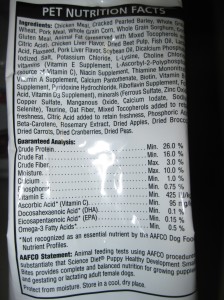The ingredient list and guaranteed analysis can be misleading without a little background knowledge. We’ll start by looking at the ingredient list. Food companies are required to list all ingredients in order by weight. What you may not know is that the ingredients are weighed before they are cooked, so what is listed as the first ingredient on the bag may not be the most abundant ingredient after cooking (especially for dry kibble). Meat is about 75% water, so it could move down the list quite a bit after cooking. So keep this in mind if a company claims their food is superior because they listed meat as the first ingredient!
The ingredients must be listed by their common or usual name, and most of them have definitions set by AAFCO (such as meat by-product or meat meal) in their Official Publication. Some of the ingredients further down the list become unfamiliar to the average consumer, but most of them are vitamins and minerals.
Here is a list of vitamins and their chemical names that are commonly listed on food bags.
The guaranteed analysis is another requirement for pet food labels. They must at least provide minimums for protein and fat, and maximums for moisture and fiber. Many pet foods will list minimums and maximums for additional nutrients as well. Many people use the guaranteed analysis to compare protein levels between different foods, however this is not a reliable way to compare foods. First of all, the moisture content varies quite a bit between foods, especially when comparing kibble to canned food. So the guaranteed analysis may state that a canned food has a minimum of 8% protein, whereas a kibble has at least 27% protein. However when the moisture is factored out, the canned food may prove to have more protein than the kibble. Foods must be compared on a dry matter basis (remove the moisture content) to get the real picture.
If you’re interested in doing these calculations yourself, the FDA webpage explains how to do the math under their guaranteed analysis section.
The other thing to keep in mind is that even though you are factoring out moisture, the guaranteed analysis is still only giving you minimums and maximums. There could be a lot more protein in a food than what the bag states, or a lot less fiber. If your pet requires a special diet (restricted proteins, or a certain balance of minerals) you should discuss feeding options with your veterinarian.
The bottom line is that you can’t really tell how much protein or carbohydrate or fat is in a diet just by glancing at the ingredient list and guaranteed analysis. Be wary of companies that try to sell their food by simplifying the comparison of their food to other brands. If you are looking for specific numbers you will need to contact the pet food company to get their average nutrient contents on a dry matter basis (these are not minimums or maximums). Those are the numbers veterinarians compare when choosing a food for a specific medical need, such as a pet with diabetes or kidney disease. Not all companies are willing or able to provide these numbers, in which case I would not recommend feeding their food, especially to a pet with specific dietary needs. You can discuss your pet’s dietary needs with your vet, and they can help you through the process to choose a food for your pet. Whatever pet food you choose, always go back to the AAFCO statement to be sure you are feeding a food that is appropriate for your pet’s life stage, and that preferably it has gone through feeding trials to ensure it is complete and balanced.



